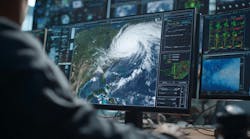The Top 10 U.S. States by Weather-related Fatalities
We check the forecast daily. Most of the time, it’s to help us decide whether to grab that coat or umbrella; it’s an innocuous, even helpful habit. Most of the time, that’s the extent of what we think about the weather.
But here’s the thing about the weather: Just about every condition can cross the threshold from typical to extreme to disaster. We might find ourselves watching the rain in summer, grateful for the much-needed water for the crops, flowers and lawns. If there’s an inch or more of rain, though, that can result in flash flooding.
Weather conditions can sometimes turn deadly, usually rapidly. That’s why it’s important to monitor the weather as a form of risk management and have emergency plans in place in the event of a natural disaster or related issue, such as supply chain disruption.
“The recent flash floods in Texas and across the East Coast show that extreme weather is no longer predictable or localized. States with no prior history of large-scale weather disasters are suddenly facing life-threatening conditions with limited preparation,” said Chandon Alexander, CEO of Spartacus Criminal Defense Lawyers. “This isn’t just about heatwaves or hurricanes. It’s about infrastructure gaps, emergency preparedness and the reality that weather fatalities can now occur in places that considered themselves safe.”
By analyzing National Weather Service data from 2014 to 2025, Spartacus Criminal Defense Lawyers analyzed where Americans face the greatest risk of death from extreme weather due to cold, flooding, heat, lightning, tornadoes, wind and winter storms. Then they ranked states based on the total weather-related fatalities per 1 million people.
Surprisingly, Texas did not make the top 10 per capita list; however, they did report the second-highest absolute death counts. Neither Florida nor Louisiana made the list, either, though that might be more of a reflection of scope of the analysis, which notably did not track hurricane-related fatalities.
Nonetheless, this list should serve as a reminder—or wake-up call, depending on perspective—that as the U.S. population shifts, more weather-vulnerable land is developed in (i.e., for housing) and climate change continues to unfold, more people will be at risk, including in areas that were previously considered safe from extreme weather conditions. In short, it’s never too soon to start preparing for more climate-related disasters or finding more ways to keep more employees (and their families and communities) safe.
Click on the image above to view the top 10 deadliest states and here for the raw data and methodology.
Read more
About the Author
Nicole Stempak
Nicole Stempak is managing editor of EHS Today and conference content manager of the Safety Leadership Conference.


